Astronomers from the University of Mexico have found a distant star system where a small, young star has been flung out of its binary star system by the gravitational interaction with its neighbours. The star, called T Tauri Component Sb, has 20% the mass of the Sun, and was part of a group of stars 450 light years from the Earth. The team has been tracking the path of the rogue star since 1983, and watched it slingshot past one star and head out into space.
Columbia Countdown Gets Started
Under a cloak of high security, NASA began the launch countdown for the Space Shuttle Columbia on Monday. If all goes well, the shuttle will launch on Thursday at a secret time – the actual launch time will only be announced 24 hours beforehand. The 16-day microgravity science mission was supposed to launch last year, but cracks discovered in shuttle fuel lines kept the whole fleet grounded while a solution was found. Isreal’s first astronaut, Ilan Ramon, is also due to take part in this mission.
ICESat Launches
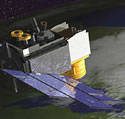
Image credit: NASA
A satellite designed to track the changes in the Earth’s major ice sheets was launched on Sunday after experiencing a month of delays due to technical difficulties. ICESsat (Ice Cloud and Land Elevation
Satellite) was launched aboard a Boeing Delta rocket from the Vandenberg US Air Force Base in California. On board the rocket was another, smaller satellite called CHIPSat, which will help astronomers study the hot gas coming off of stars.
NASA?s Ice, Cloud and Land Elevation satellite (ICESat) and Cosmic Hot Interstellar Spectrometer (CHIPS) satellite lifted off from Vandenberg Air Force Base, Calif., at 4:45 p.m. PST aboard Boeing?s Delta II rocket. Separation of the ICESat spacecraft occurred 64 minutes after launch at 5:49 p.m. PST. Initial contact with ICESat was made 75 minutes after launch at 6 p.m. PST as the spacecraft passed over the Svalbard Ground Station in Norway.
The CHIPS spacecraft separated from the launch vehicle 83 minutes after launch at 6:08 p.m. PST. Initial contact with CHIPS was made 98 minutes after launch at 6:23 p.m. PST as the spacecraft passed over the University of California, Berkeley.
?The Delta vehicle gave us a great ride! The ICESat spacecraft was right where we expected and is performing great. The whole team is thrilled to be having such a wonderful start to our mission? said Jim Watzin, the ICESat Project Manager at NASA?s Goddard Space Flight Center in Greenbelt, Md.
Over the next few days the ICESat spacecraft will gradually be despun and placed into a safe stable attitude. Within two weeks the onboard propulsion system will gradually tune the orbit. Once in its final orbital position, ICESat will be approximately 373 miles (600 kilometers) above the Earth.
ICESat is the latest in a series of Earth Observing System spacecraft, following the Terra satellite launched in December 1999, and the Aqua satellite launched earlier in May of this year. The primary role of ICESat is to quantify ice sheet growth or retreat and to thereby answer questions concerning many related aspects of the Earth?s climate system, including global climate change and changes in sea level.
Ball Aerospace and Technologies Corporation (Ball) in Boulder, Colorado built the ICESat spacecraft. The Earth Science Data and Information System at NASA Goddard will provide space and ground network support and the University of Colorado?s Laboratory for Atmospheric and Space Physics will team with Ball to provide mission operations and flight dynamics support. The GLAS and ICESat data will be initially processed at the ICESat Investigator-led Processing System with support from the University of Texas, Center for Space Research. The mission data will be distributed and archived by the National Snow and Ice Data Center.
Original Source: NASA News Release
Hubble Spots Earliest Bright Objects
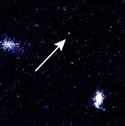
Image credit: Hubble
The most recent photos released from the Hubble Space Telescope show objects so old they might be from a time when stars in the universe were just starting to shine in significant numbers – about 13 billion years ago. These objects are at the limit of Hubble’s resolving power, but the next generation James Webb Space Telescope is expected to see the entire group of proto-galaxies, and look back even further.
Researchers using NASA’s Hubble Space Telescope reported today they are seeing the conclusion of the cosmic epoch called the “Dark Ages,” a time about a billion years after the big bang when newly-formed stars and galaxies were just starting to become visible.
“With the Hubble Telescope, we can now see back to the epoch when stars in young galaxies began to shine in significant numbers, concluding the cosmic ‘dark ages’ about 13 billion years ago,” said Haojing Yan, a Ph.D. graduate student at Arizona State University (ASU). The results are being presented at the meeting of the American Astronomical Society in Seattle, WA.
Current theory holds that after the big bang that created the universe, there was a time of expansion and cooling that led to what is known as the “dark ages” in cosmic terms. The universe cooled sufficiently for protons and electrons to combine to form neutral hydrogen atoms and block the transmission of light. This epoch started about 300,000 years after the big bang, and may have ended about a billion years later. Stars and galaxies started to form at some point during this era, but the omni-present neutral hydrogen in the universe absorbed the ultraviolet light produced by stars and can not be seen by current telescopes.
The ASU team reports that Hubble’s Advanced Camera for Surveys (ACS) is revealing numerous faint objects that may be young star-forming galaxies seen when the universe was seven times smaller than it is today and less than a billion years old.
This was an important transition in the evolution of the universe. Because ionized hydrogen does not absorb ultraviolet light as easily as neutral hydrogen, the Dark Ages came to an end when enough hot stars had formed that their ultraviolet light pervaded the universe and re-ionized the neutral hydrogen. The shining stars opened a window for astronomers to look very far back into time.
“The objects we found are in the epoch when the universe started to produce stars in significant numbers ?- the hard-to-find young galaxies,” says Rogier Windhorst, professor of astronomy at ASU. “These galaxies are at the boundary of the directly observable universe.”
The ASU team found the objects while examining a small portion of the sky in the spring zodiacal constellation Virgo. This particular area of the sky contains no known bright galaxies, helping reduce light contamination in the observations. The entire ACS field of view shows about thirty such faint red objects. The distances to the suspected young galaxies are believed to be quite large, based on how red the observed objects are compared with nearby galaxies.
Based on this sample, the ASU researchers estimate that at least 400 million such objects filled in the entire universe at this cosmic epoch, to the limit of this Hubble image. And, they say they are able to see only the tip of the iceberg with current telescopes such as Hubble. NASA’s planned 7-meter James Webb Space Telescope is expected to see the entire population of these proto-galactic objects after it is launched in 2010.
Original Source: Hubble News Release
Gravity Moves at the Speed of Light
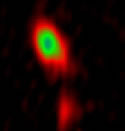
Image credit: NRAO
Theorized by Einstein for almost a century, physicists have found evidence to support the theory that the force of gravity moves at the speed of light. The speed was measured by physicist Sergei Kopeikin by watching how light from a distant quasar was bent by Jupiter’s gravity. Variations in how the image of the quasar was bent accounted for this speed of gravity.
Taking advantage of a rare cosmic alignment, scientists have made the first measurement of the speed at which the force of gravity propagates, giving a numerical value to one of the last unmeasured fundamental constants of physics.
“Newton thought that gravity’s force was instantaneous. Einstein assumed that it moved at the speed of light, but until now, no one had measured it,” said Sergei Kopeikin, a physicist at the University of Missouri-Columbia.
“We have determined that gravity’s propagation speed is equal to the speed of light within an accuracy of 20 percent,” said Ed Fomalont, an astronomer at the National Radio Astronomy Observatory (NRAO) in Charlottesville, VA. The scientists presented their findings to the American Astronomical Society’s meeting in Seattle, WA.
The landmark measurement is important to physicists working on unified field theories that attempt to combine particle physics with Einstein’s general theory of relativity and electromagnetic theory.
“Our measurement puts some strong limits on the theories that propose extra dimensions, such as superstring theory and brane theories,” Kopeikin said. “Knowing the speed of gravity can provide an important test of the existence and compactness of these extra dimensions,” he added.
Superstring theory proposes that the fundamental particles of nature are not pointlike, but rather incredibly small loops or strings, whose properties are determined by different modes of vibration. Branes (a word derived from membranes) are multidimensional surfaces, and some current physical theories propose space-time branes embedded to five dimensions.
The scientists used the National Science Foundation’s Very Long Baseline Array (VLBA), a continent-wide radio-telescope system, along with the 100-meter radio telescope in Effelsberg, Germany, to make an extremely precise observation when the planet Jupiter passed nearly in front of a bright quasar on September 8, 2002.
The observation recorded a very slight “bending” of the radio waves coming from the background quasar by the gravitational effect of Jupiter. The bending resulted in a small change in the quasar’s apparent position in the sky.
“Because Jupiter is moving around the Sun, the precise amount of the bending depends slightly on the speed at which gravity propagates from Jupiter,” Kopeikin said.
Jupiter, the largest planet in the Solar System, only passes closely enough to the path of radio waves from a suitably bright quasar about once a decade for such a measurement to be made, the scientists said.
The once-in-a-decade celestial alignment was the last in a chain of events that made measuring the speed of gravity possible. The others included a chance meeting of the two scientists in 1996, a breakthrough in theoretical physics and the development of specialized techniques that enabled the extremely precise measurement to be made.
“No one had tried to measure the speed of gravity before because most physicists had assumed that the only way to do so was to detect gravitational waves,” Kopeikin recalled. However, in 1999, Kopeikin extended Einstein’s theory to include the gravitational effects of a moving body on light and radio waves. The effects depended on the speed of gravity. He realized that if Jupiter moved nearly in front of a star or radio source, he could test his theory.
Kopeikin studied the predicted orbit of Jupiter for the next 30 years and discovered that the giant planet would pass closely enough in front of the quasar J0842+1835 in 2002. However, he quickly realized that the effect on the quasar’s apparent position in the sky attributable to the speed of gravity would be so small that the only observational technique capable of measuring it was Very Long Baseline Interferometry (VLBI), the technique embodied in the VLBA. Kopeikin then contacted Fomalont, a leading expert in VLBI and an experienced VLBA observer.
“I immediately realized the importance of an experiment that could make the first measurement of a fundamental constant of nature,” Fomalont said. “I decided that we had to give this our best shot,” he added.
To get the required level of precision, the two scientists added the Effelsberg telescope to their observation. The wider the separation between two radio-telescope antennas, the greater is the resolving power, or ability to see fine detail, achievable. The VLBA includes antennas on Hawaii, the continental United States, and St. Croix in the Caribbean. An antenna on the other side of the Atlantic added even more resolving power.
“We had to make a measurement with about three times more accuracy than anyone had ever done, but we knew, in principle, that it could be done,” Fomalont said. The scientists tested and refined their techniques in “dry runs,” then waited for Jupiter to make its pass in front of the quasar.
The wait included considerable nail-biting. Equipment failure, bad weather, or an electromagnetic storm on Jupiter itself could have sabotaged the observation. However, luck held out and the scientists’ observations at a radio frequency of 8 GigaHertz produced enough good data to make their measurement. They achieved a precision equal to the width of a human hair seen from 250 miles away.
“Our main goal was to rule out an infinite speed for gravity, and we did even better. We now know that the speed of gravity is probably equal to the speed of light, and we can confidently exclude any speed for gravity that is over twice that of light,” Fomalont said.
Most scientists, Kopeikin said, will be relieved that the speed of gravity is consistent with the speed of light. “I believe this experiment sheds new light on fundamentals of general relativity and represents the first of many more studies and observations of gravitation which are currently possible because of the enormously high precision of VLBI. We have a lot more to learn about this intriguing cosmic force and its relationship to the other forces in nature,” Kopeikin said.
This is not the first time that Jupiter has played a part in producing a measurement of a fundamental physical constant. In 1675, Olaf Roemer, a Danish astronomer working at the Paris Observatory, made the first reasonably accurate determination of the speed of light by observing eclipses of one of Jupiter’s moons.
Original Source: NRAO News Release
Neptune Has a Trojan
Astronomers have discovered a new object which shares a very similar orbit with Neptune. Part of a classification of objects called Trojans, 2001 QR322 is 230 km across and requires 166 years to orbit the Sun. Although clusters of Trojans have been found following Jupiter’s orbit, none have ever been found to share an orbit with any other giant planet; although, they’ve been predicted for years.
Protoplanetary Disk Found Around a Star
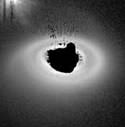
Image credit: Hubble
The new Advanced Camera for Surveys (ACS) on the Hubble Space Telescope has revealed a clear disk of dust around a young, 5 million year old star. Astronomers believe these disks are the birthplaces of planets. The star, called HD 141569A is part of a triple star system located 320 light-years away in the constellation of Libra.
NASA Hubble Space Telescope’s new Advanced Camera for Surveys (ACS) has given astronomers their clearest view yet of the dust disk around a young, 5-million-year-old star. Such disks are expected to be the birthplace of planets. The star, called HD 141569A, lies 320 light-years away in the constellation Libra and appears to be a member of a triple-star system.
The star HD 141569A was first identified as a candidate for a circumstellar disk in 1986, from observations done with the NASA/Netherlands/United Kingdom Infrared Astronomy Satellite (IRAS). An excess of infrared radiation associated with the star provides telltale evidence for the presence of a dust disk. Hubble’s Near Infrared Camera and Multi-Object Spectrometer photographed the disk in 1999 and revealed two concentric rings divided by a dark lane. This was interpreted as evidence of dynamical sculpting by one or more planets.
The ACS reveals that the disk’s structure is much more complex than previously thought. The disk is actually a tightly wound spiral structure. The outer regions of the disk reveal two diffuse spiral arms, one of which appears to be associated with the nearby double star system (HD 141569BC) seen at the upper left. The apparent connection between the disk and the double star suggest that an interaction with the double star may be responsible for the structures seen in the disk.
However, previous mid-IR images of the disk show that it is relatively clear of dust within approximately 2.8 billion miles of the star. This inner region may have been swept clear by one or more unseen planets.
These observations of the disk were obtained with the ACS’s High Resolution Camera (HRC) coronagraph. The photo on the left is a processed visible light image. In the photo on the right, the disk has been geometrically altered to simulate a face-on view, and false-color has been applied to enhance the disk structure. The black center marks regions where light from the star has been masked out. These images are the first results of a survey of disks around young main-sequence stars being conducted by the ACS science team.
Original Source: Hubble News Release
Hubble Uses Galactic Lens to Look Further
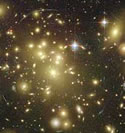
Image credit: Hubble
The Hubble Space Telescope has used a natural 2-million-light-year wide “zoom lens” to look further into space than it normally could. By peering directly through the centre of one of the most massive galactic clusters known, it was able to take advantage of a technique called gravitational lensing to see objects beyond the cluster. Detailed analysis of the image may help shed some light on the mystery of dark matter.
The Advanced Camera for Surveys aboard NASA’s Hubble Space Telescope has used a natural “zoom lens” in space to boost its view of the distant universe. Besides offering an unprecedented and dramatic new view of the cosmos, the results promise to shed light on galaxy evolution and dark matter in space.
Hubble peered straight through the center of one of the most massive galaxy clusters known, called Abell 1689. This required that Hubble gaze at the distant cluster, located 2.2 billion light-years away, for over 13 hours. The gravity of the cluster’s trillion stars ? plus dark matter ? acts as a 2-million-light-year-wide “lens” in space. This “gravitational lens” bends and magnifies the light of galaxies located far behind it.
The Advanced Camera’s IMAX movie-quality sharpness, combined with the behemoth lens, reveals remote galaxies previously beyond even Hubble’s reach. A few may be twice as faint as those photographed in the Hubble Deep Field, which previously pushed the telescope to its sensitivity limits. Though much more analysis is needed, Hubble astronomers speculate that some of the faintest objects in the picture are probably over 13 billion light-years away (redshift value 6).
In the image hundreds of galaxies many billions of light-years away are smeared by the gravitational bending of light into a spider-web tracing of blue and red arcs of light. Though gravitational lensing has been studied previously with Hubble and ground-based telescopes, this phenomenon has never been seen before in such detail. The ACS picture reveals 10 times more arcs than would be seen by a ground-based telescope. The ACS is 5 times more sensitive and provides pictures that are twice as sharp as the previous work-horse Hubble cameras. So it can see the very faintest arcs with greater clarity. The picture presents an immense jigsaw puzzle for Hubble astronomers to spend months untangling. Interspersed with the foreground cluster are thousands of galaxies, which are lensed images of the galaxies in the background universe.
Detailed analysis of the images promises to shed light on the mystery of dark matter. Dark matter is an invisible form of matter. It is the source of most of the gravity in the universe because it is much more abundant than the “normal matter” that makes up planets, stars and galaxies. The lensing allows astronomers to map the distribution of dark matter in galaxy clusters. This should offer new clues to the nature of dark matter. By studying the lensed distant galaxies, astronomers expect to better trace the history of star formation in the universe, over the past 13 billion years.
The picture is an exquisite demonstration of Albert Einstein’s prediction that gravity warps space and therefore distorts a beam of light, like a rippled shower curtain. Though Einstein realized this effect would happen in space, he thought it could never be observed from Earth. Though individual stars lens background light, the deflection was too small to ever be seen from Earth. When the laws of relativity were formulated in the early 20th century, scientists did not know that stars were organized into galaxies beyond our own Milky Way. Great clusters of galaxies are massive enough to warp space and deflect light in a way that is detectable from Earth. The Abell cluster is the ideal target because it is so massive. The more massive a cluster, the larger the effects of gravitational lensing.
Original Source: Hubble News Release
Gullies on Mars Not Formed by Water?
Gullies on Mars were discovered in 2001 that seemed to show evidence that liquid water had been on the surface of the planet very recently. But a theory from a University of Melbourne geologist examines the possibility that the gullies were carved by an avalanche of carbon dioxide changing directly from a solid to a gas. This theory has been met with skepticism from other Mars researchers, who are hoping that liquid water might someday be found on Mars, increasing the possibility of finding life.
An Australian geologist has identified what could be the first ever active flow of fluids through gullies on Mars.
University of Melbourne geologist, Dr Nick Hoffman, identified recent gully and channel development near the polar regions of Mars from images taken by the Mars Global Surveyor spacecraft. But contrary to the majority of scientific opinion which suggests that such features were carved by liquid water, Hoffman says the flow is most likely frozen carbon dioxide.
NASA is desperate to find signs of liquid water on Mars so they have a target for the next generation of Mars landers and rovers to go and search for life, but their search could prove fruitless if Hoffman’s analysis of the images is correct.
In the latest edition of the journal Astrobiology, Hoffman presents evidence for the flow events on Mars and demonstrates that there are substances other than water that can flow on Mars and that water is probably the least likely substance to do this. Hoffman says the channels he identified from the Surveyor images are more likely being carved by avalanches of carbon dioxide and associated debris.
“The consequences of this for life on Mars are shattering. If similar mechanisms are responsible for all the recent gullies on Mars then the near surface life NASA is so desperately searching for may not exist,” says Hoffman.
“Without liquid water there cannot be life and despite recent reports of more and more ice on the Red Planet, NASA has yet to find liquid water,” he says.
Many NASA scientists are doubtful about Hoffman’s observations, but at a meeting of the American Geophysical Union held last month, Hoffman says they struggled to find arguments against the evidence he presented.
The Mars Gullies were discovered in 2001. Hoffman’s analysis of the recent images shows that a patch of gullies near the South Pole shows signs of annual flow activity each Martian Spring.
“In itself the observation of active flows is a dramatic discovery since no movement has yet been seen on Mars, except for some dry dust avalanches. The gullies are thought to be the most promising candidates for liquid water flows on modern Mars and many NASA researchers are suggesting ways in which they might be formed by liquid water, but nobody has yet seen the gullies in action,” says Hoffman.
Hoffman suggests NASA researchers missed these most exciting events happening in the gullies as they have been focussed on looking for liquid water in late summer.
“In the Martian Spring, when carbon dioxide frost and snow at temperatures of minus130 degrees Centigrade still fill the valleys, flow events are occurring. The flows cut through the frost at temperatures that would turn battery acid into building stone,” he says.
“Nothing based on water can flow at these temperatures, so the culprit must be defrosting carbon dioxide.
“But carbon dioxide doesn’t melt on Mars; it boils directly from the solid (a process called ‘sublimation’). Instead of a trickle or gush of liquid pouring down the gully, the flow appears to be a flurry of boiling dry ice avalanching down the gully. The boiling dry ice acts like a amarda of miniature hovercraft carrying a shower of sand, dust, and tumbling rocks down the slope, carving out the gullies as it goes.
Original Source: University of Melbourne News Release
Ariane Inquiry Board Submits its Findings
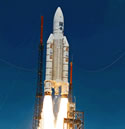
Image credit: Arianespace
According to a commission of inquiry, the failure of the new Ariane 5-ESCA rocket appears to have been caused by a leakage in the cooling system. Approximately 456 seconds into the vehicle’s flight, it veered off course and had to be destroyed. With it went two satellites worth 600 million euros. The results of this inquiry clear the way for the launch of the Rosetta comet mission in the next few weeks.
The Inquiry Board appointed to investigate the failure of Flight 157 submitted its report to Arianespace on January 6, 2003. The board was named last December 13 to establish the causes of the anomaly during the flight of an Ariane 5 ECA on the night of December 11-12, 2002.
As requested, the board established the most probable cause for the mission failure, examined possible consequences for the baseline Ariane 5 launcher version, and recommended actions to correct the problems that occurred during the Ariane 5 ECA flight
Arianespace has accepted all the recommendations of the board, and will prepare an action plan by January 20 to enable a return to service of the Ariane 5 ECA during the second half of 2003.
The Inquiry Board
Cause of the failure
A complete analysis of all measurements recorded during Flight 157 was carried out, along with a review of documentation concerning production, quality and technical records for the Ariane 5 ECA, as well as for all Ariane 5 flights to date. Also reviewed by the board was the work of production and development teams in Europe.
The board’s findings confirm that all preparatory and countdown operations for Flight 157 went normally, as did the flight sequence until the separation of the solid boosters.
The report of the Inquiry Board did identify the occurrence of a leak in the of the Vulcain 2 nozzle’s cooling circuit during this first flight phase, followed by a critical overheating of the nozzle – which led to a loss of its integrity.
This resulted in a major imbalance in the thrust of the Vulcain 2 engine due to the nozzle’s deterioration, leading to a loss of control over the launcher’s trajectory.
# In conclusion, the most probable cause of the failure of Flight 157 was the simultaneous occurrence of two aggravating factors: The degraded thermal condition of the nozzle due to fissures in the cooling tubes, and
# Non-exhaustive definition of the loads to which the Vulcain 2 engine is subjected during flight
The board also noted that it would be difficult to simulate these additional loads during ground tests.
Consequences for the Ariane 5 Baseline
The designs of nozzles on the Ariane 5 Baseline’s Vulcain 1 engine and the Vulcain 2 engine for Ariane 5 ECA differ in two main ways:
# The shape of the cooling tubes, which form the structure of the nozzle, and
# The technology of the nozzle’s stiffeners.
After reviewing operating data from the Vulcain 1 engine’s 12 successful flights, the Inquiry Board did not identify any weaknesses concerning the functioning and resistance of its nozzle. The Inquiry Board nevertheless requested an exhaustive examination of the behavior of the Vulcain 1 engine nozzle, including precise modeling to demonstrate the component’s correct behavior during the flight. These verifications currently are in progress.
Consequences for Ariane 5 ECA
The Inquiry Board requested that the following actions be taken:
# Modification of the Vulcain 2 nozzle, taking into account experience acquired with the Vulcain 1 engine nozzle,
# Assessment of possibilities for simulation during ground tests of loads observed during actual flight on the Vulcain 2 engine, and
# Enhancing of the quality of flight equipment.
Consequences for Rosetta launch
In view of the specific factors involved in this flight, Arianespace has decided to create a Review Board to make a decision on Tuesday, January 14 regarding the mission’s launch date.
Upcoming Arianespace launches
# February 11: Ariane 4
# Second half of February: an Ariane 5 Baseline launcher version
Original Source: Arianespace News Release
